Oil Lancia Ypsilon 2002 Owner handbook (in English)
[x] Cancel search | Manufacturer: LANCIA, Model Year: 2002, Model line: Ypsilon, Model: Lancia Ypsilon 2002Pages: 191, PDF Size: 2.45 MB
Page 9 of 191
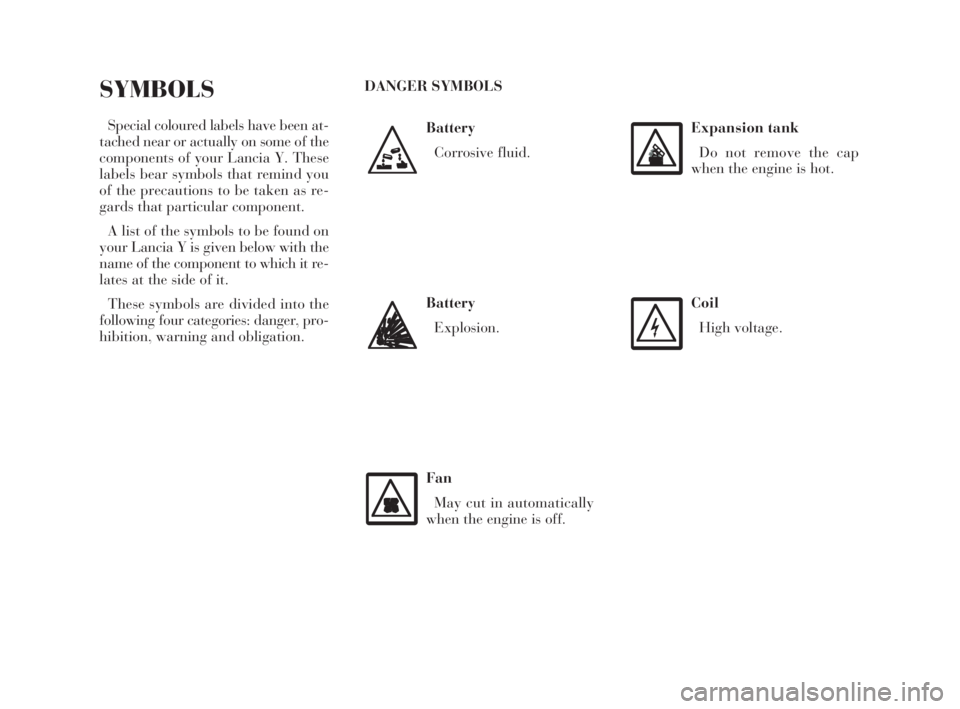
G
Battery
Corrosive fluid.
SYMBOLS
Special coloured labels have been at-
tached near or actually on some of the
components of your Lancia Y. These
labels bear symbols that remind you
of the precautions to be taken as re-
gards that particular component.
A list of the symbols to be found on
your Lancia Y is given below with the
name of the component to which it re-
lates at the side of it.
These symbols are divided into the
following four categories: danger, pro-
hibition, warning and obligation.DANGER SYMBOLS
Battery
Explosion.
Fan
May cut in automatically
when the engine is off.
Expansion tank
Do not remove the cap
when the engine is hot.
Coil
High voltage.
4C001-067 ING 11-03-2008 11:57 Pagina 6
Page 37 of 191
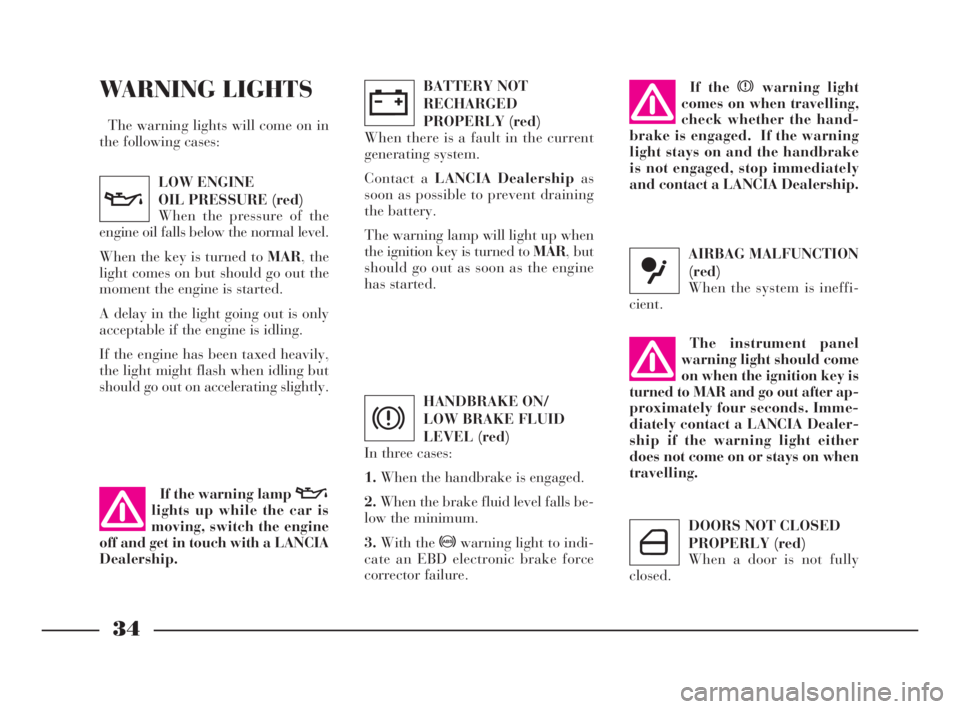
34
G
WARNING LIGHTS
The warning lights will come on in
the following cases:
LOW ENGINE
OIL PRESSURE (red)
When the pressure of the
engine oil falls below the normal level.
When the key is turned to MAR, the
light comes on but should go out the
moment the engine is started.
A delay in the light going out is only
acceptable if the engine is idling.
If the engine has been taxed heavily,
the light might flash when idling but
should go out on accelerating slightly.
v
BATTERY NOT
RECHARGED
PROPERLY (red)
When there is a fault in the current
generating system.
Contact a LANCIA Dealership as
soon as possible to prevent draining
the battery.
The warning lamp will light up when
the ignition key is turned to MAR, but
should go out as soon as the engine
has started.
w
If the warning lamp v
lights up while the car is
moving, switch the engine
off and get in touch with a LANCIA
Dealership.
HANDBRAKE ON/
LOW BRAKE FLUID
LEVEL (red)
In three cases:
1.When the handbrake is engaged.
2.When the brake fluid level falls be-
low the minimum.
3.With the >warning light to indi-
cate an EBD electronic brake force
corrector failure.
x
If the xwarning light
comes on when travelling,
check whether the hand-
brake is engaged. If the warning
light stays on and the handbrake
is not engaged, stop immediately
and contact a LANCIA Dealership.
AIRBAG MALFUNCTION
(red)
When the system is ineffi-
cient.
û
The instrument panel
warning light should come
on when the ignition key is
turned to MAR and go out after ap-
proximately four seconds. Imme-
diately contact a LANCIA Dealer-
ship if the warning light either
does not come on or stays on when
travelling.
DOORS NOT CLOSED
PROPERLY (red)
When a door is not fully
closed.
´
4C001-067 ING 11-03-2008 11:57 Pagina 34
Page 51 of 191

48
G
A key C (fig. 67)is attached to the
back of the cover B (fig. 67); insert
this key into D (fig. 68) and turn it to
manually perform the operations de-
scribed previously (opening/closing).
To reach D, remove the press-fitted
cover.
fig. 68
P4C00187
Do not open the roof if
there is snow or ice on it as
you risk damaging it.
SUNROOF
The sunroof is electrically operated.
It will only work if the ignition key
is at MAR.
ButtonA (fig. 65)on the ceiling light
unit controls the opening, closing,
raising and lowering of the roof.
When you release the button, the
roof locks in the position it is in at
that moment.
£Press once to open in the spoiler
position.
Press again to open completely.
¢Press to close.
fig. 65
P4C00101
A sliding sunshade, fitted under the
sunroof, will lessen the effect of the
sun’s rays or the amount of air enter-
ing the car (fig. 66).
If there is an electrical fault in the
sunroof, open the glove compartment.
fig. 66
P4C00102
fig. 67
P4C00103
4C001-067 ING 11-03-2008 11:57 Pagina 48
Page 54 of 191

51
G
BOOT
OPENING/CLOSING
THE TAILGATE
To open the boot from the outside,
unlock it with the ignition key A
(fig. 72).
To open it from inside the car, pull
leverA (fig. 73)at the side of the dri-
ver’s seat.
To lift the tailgate, use the grip lo-
cated between the two number plate
lights.When the tailgate is closed, it will
lock automatically, and can only be
reopened by using the key or pulling
leverA (fig. 73)inside the car.
IMPORTANTNever leave the keys
in the boot.
Use the handle situated in the inte-
rior trim of the tailgate A (fig. 74)to
lower it without getting your hands
dirty.
To close the tailgate, lower it and
press in the centre until you hear it
lock.
fig. 72
P4C00021
fig. 73
P4C00015
Do not work boot release
lever when the car is in
motion.
The addition of objects to
the rear parcel shelf or
tailgate (loudspeakers,
spoiler, etc.) may prevent the gas-
filled struts at the sides of the tail-
gate working properly. Items
arranged on the rear window shelf
could be thrown forwards and in-
jure passengers should you brake
sharply.
fig. 74
P4C00037
When using the boot,
make sure the load you are
carrying does not exceed
the permitted weight (see the
“Technical specifications” sec-
tion). Also ensure the items in the
boot are arranged properly to pre-
vent them being thrown forward
and injurying passengers should
you brake sharply.
4C001-067 ING 11-03-2008 11:57 Pagina 51
Page 76 of 191
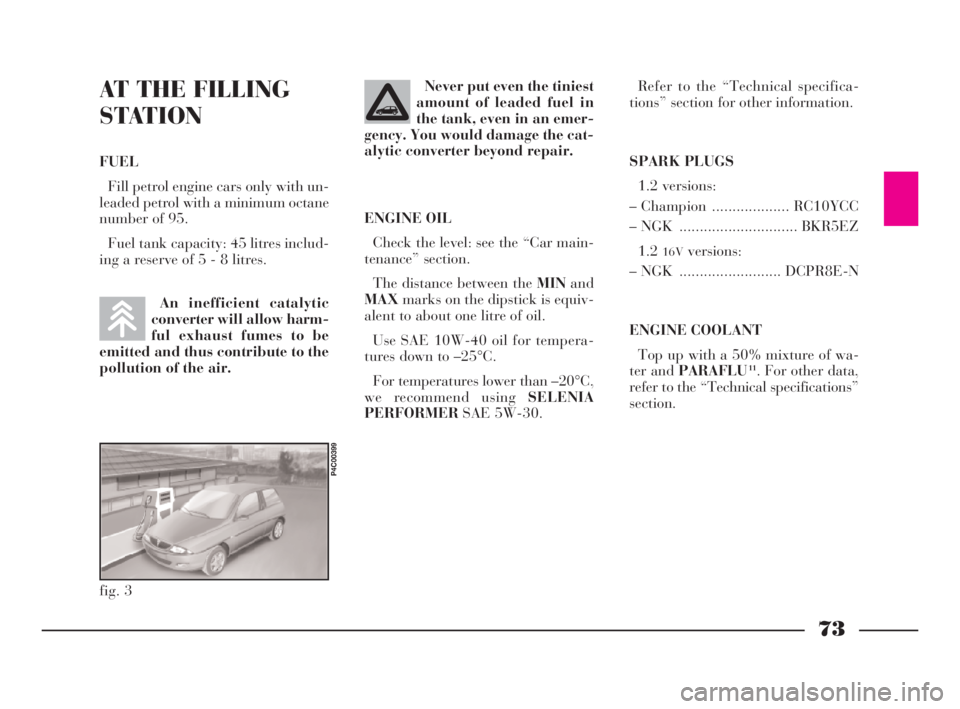
73
G
AT THE FILLING
STATION
FUEL
Fill petrol engine cars only with un-
leaded petrol with a minimum octane
number of 95.
Fuel tank capacity: 45 litres includ-
ing a reserve of 5 - 8 litres.Never put even the tiniest
amount of leaded fuel in
the tank, even in an emer-
gency. You would damage the cat-
alytic converter beyond repair.
ENGINE OIL
Check the level: see the “Car main-
tenance” section.
The distance between the MINand
MAXmarks on the dipstick is equiv-
alent to about one litre of oil.
Use SAE 10W-40 oil for tempera-
tures down to –25°C.
For temperatures lower than –20°C,
we recommend using SELENIA
PERFORMERSAE 5W-30.Refer to the “Technical specifica-
tions” section for other information.
SPARK PLUGS
1.2 versions:
– Champion ................... RC10YCC
– NGK ............................. BKR5EZ
1.2
16Vversions:
– NGK ......................... DCPR8E-N
ENGINE COOLANT
Top up with a 50% mixture of wa-
ter and PARAFLU
11. For other data,
refer to the “Technical specifications”
section.
An inefficient catalytic
converter will allow harm-
ful exhaust fumes to be
emitted and thus contribute to the
pollution of the air.
fig. 3
P4C00399
4C068-089 ING 11-03-2008 11:59 Pagina 73
Page 79 of 191

76
G
Consider the space re-
quired by extra mats: even
a small problem to the
braking system may indicate addi-
tional brake pedal stroke is re-
quired with respect to normal.
Water, ice and salt sprin-
kled on the road deposit
on the brake disc and re-
duce effectiveness the first time
you brake.
WHEN TRAVELLING
– The first rule of safe driving is pru-
dence.
– Prudence also means putting your-
self into a position where you can pre-
dict wrong or imprudent behaviour
from other drivers.
– Stick closely to the rules of the
road in the particular country where
the car is being driven and, above all,
do not exceed speed limits.
– Ensure that, besides yourself, all
the other passengers in the car have
their seat belts fastened, that children
are sitting in the appropriate child
seats and any animals are in special
compartments.
– You should be physically fit and
mentally alert before setting out on
long journeys.Driving when you are not
mentally alert, drunk, un-
der the influence of drugs
or certain medicines is dangerous
both for you and other road users.
Always fasten both front
and back seat belts in-
cluding child seat seat belt
if fitted. Travelling with the seat
belts unfastened increases the risk
of injury or death if you are in a
collision.
Pay attention when in-
stalling additional spoil-
ers, alloy wheel rims and
caps that are not standard. They
could reduce the brake ventilation
and as a consequence, the braking
efficiency if you brake suddenly
and repeatedly, or when driving
downhill.Do not drive with objects
on the floor in front of the
driver’s seat. Objects
could get stuck under the pedals
making accelerating and braking
impossible.
4C068-089 ING 11-03-2008 11:59 Pagina 76
Page 84 of 191
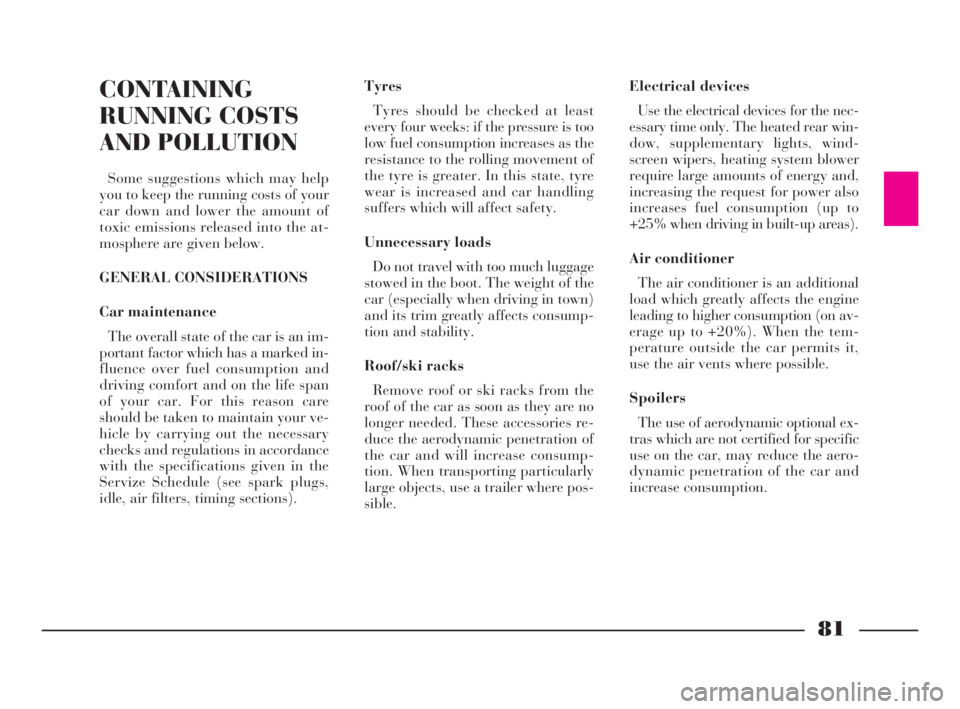
81
G
CONTAINING
RUNNING COSTS
AND POLLUTION
Some suggestions which may help
you to keep the running costs of your
car down and lower the amount of
toxic emissions released into the at-
mosphere are given below.
GENERAL CONSIDERATIONS
Car maintenance
The overall state of the car is an im-
portant factor which has a marked in-
fluence over fuel consumption and
driving comfort and on the life span
of your car. For this reason care
should be taken to maintain your ve-
hicle by carrying out the necessary
checks and regulations in accordance
with the specifications given in the
Servize Schedule (see spark plugs,
idle, air filters, timing sections).Tyres
Tyres should be checked at least
every four weeks: if the pressure is too
low fuel consumption increases as the
resistance to the rolling movement of
the tyre is greater. In this state, tyre
wear is increased and car handling
suffers which will affect safety.
Unnecessary loads
Do not travel with too much luggage
stowed in the boot. The weight of the
car (especially when driving in town)
and its trim greatly affects consump-
tion and stability.
Roof/ski racks
Remove roof or ski racks from the
roof of the car as soon as they are no
longer needed. These accessories re-
duce the aerodynamic penetration of
the car and will increase consump-
tion. When transporting particularly
large objects, use a trailer where pos-
sible.Electrical devices
Use the electrical devices for the nec-
essary time only. The heated rear win-
dow, supplementary lights, wind-
screen wipers, heating system blower
require large amounts of energy and,
increasing the request for power also
increases fuel consumption (up to
+25% when driving in built-up areas).
Air conditioner
The air conditioner is an additional
load which greatly affects the engine
leading to higher consumption (on av-
erage up to +20%). When the tem-
perature outside the car permits it,
use the air vents where possible.
Spoilers
The use of aerodynamic optional ex-
tras which are not certified for specific
use on the car, may reduce the aero-
dynamic penetration of the car and
increase consumption.
4C068-089 ING 11-03-2008 11:59 Pagina 81
Page 91 of 191
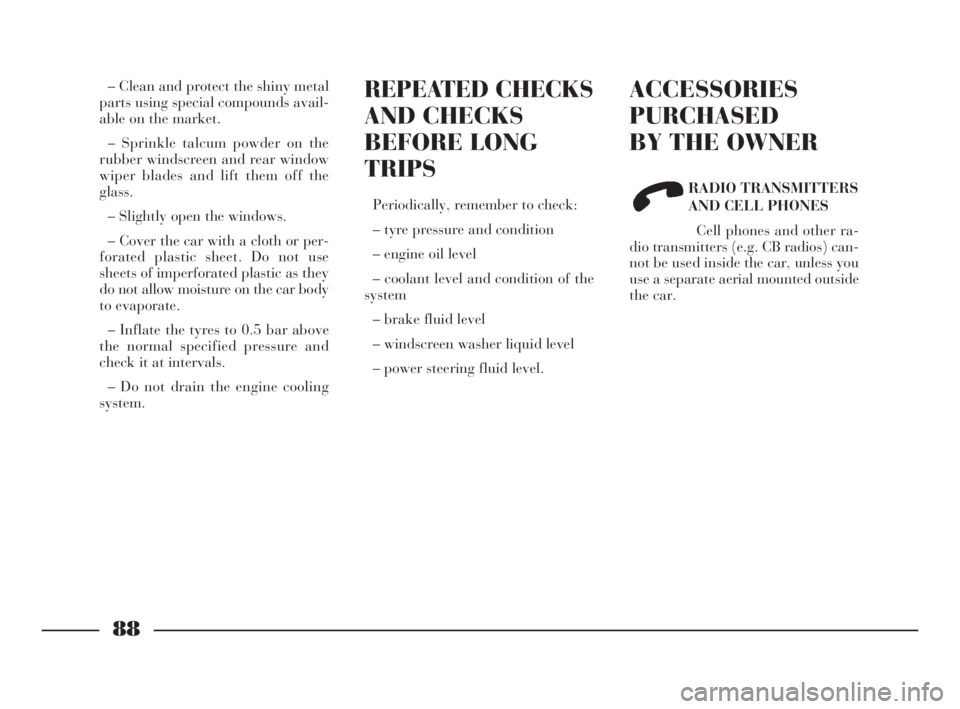
88
G
REPEATED CHECKS
AND CHECKS
BEFORE LONG
TRIPS
Periodically, remember to check:
– tyre pressure and condition
– engine oil level
– coolant level and condition of the
system
– brake fluid level
– windscreen washer liquid level
– power steering fluid level.
ACCESSORIES
PURCHASED
BY THE OWNER
RADIO TRANSMITTERS
AND CELL PHONES
Cell phones and other ra-
dio transmitters (e.g. CB radios) can-
not be used inside the car, unless you
use a separate aerial mounted outside
the car.
– Clean and protect the shiny metal
parts using special compounds avail-
able on the market.
– Sprinkle talcum powder on the
rubber windscreen and rear window
wiper blades and lift them off the
glass.
– Slightly open the windows.
– Cover the car with a cloth or per-
forated plastic sheet. Do not use
sheets of imperforated plastic as they
do not allow moisture on the car body
to evaporate.
– Inflate the tyres to 0.5 bar above
the normal specified pressure and
check it at intervals.
– Do not drain the engine cooling
system.
4C068-089 ING 11-03-2008 11:59 Pagina 88
Page 115 of 191
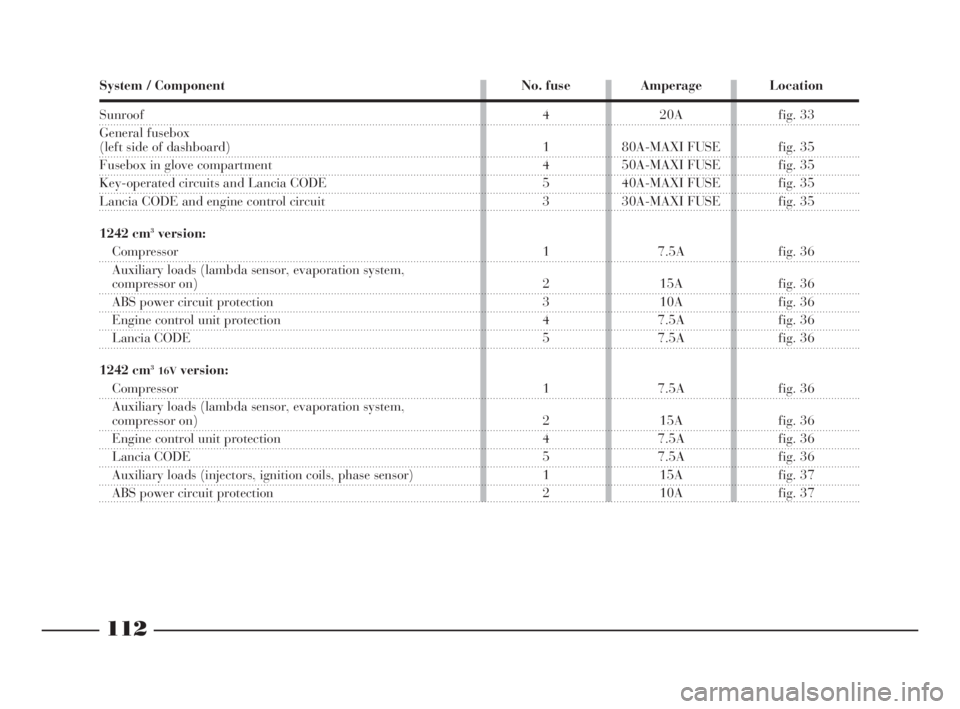
112
fG
System / Component No. fuse Amperage Location
Sunroof
General fusebox
(left side of dashboard)
Fusebox in glove compartment
Key-operated circuits and Lancia CODE
Lancia CODE and engine control circuit
1242 cm
3version:
Compressor
Auxiliary loads (lambda sensor, evaporation system,
compressor on)
ABS power circuit protection
Engine control unit protection
Lancia CODE
1242 cm
316Vversion:
Compressor
Auxiliary loads (lambda sensor, evaporation system,
compressor on)
Engine control unit protection
Lancia CODE
Auxiliary loads (injectors, ignition coils, phase sensor)
ABS power circuit protection4 20A fig. 33
1 80A-MAXI FUSE fig. 35
4 50A-MAXI FUSE fig. 35
5 40A-MAXI FUSE fig. 35
3 30A-MAXI FUSE fig. 35
1 7.5A fig. 36
2 15A fig. 36
3 10A fig. 36
4 7.5A fig. 36
5 7.5A fig. 36
1 7.5A fig. 36
2 15A fig. 36
4 7.5A fig. 36
5 7.5A fig. 36
1 15A fig. 37
2 10A fig. 37
les
00
ed
az-
ve
4C090-119 ING 13-03-2008 12:51 Pagina 112
Page 126 of 191
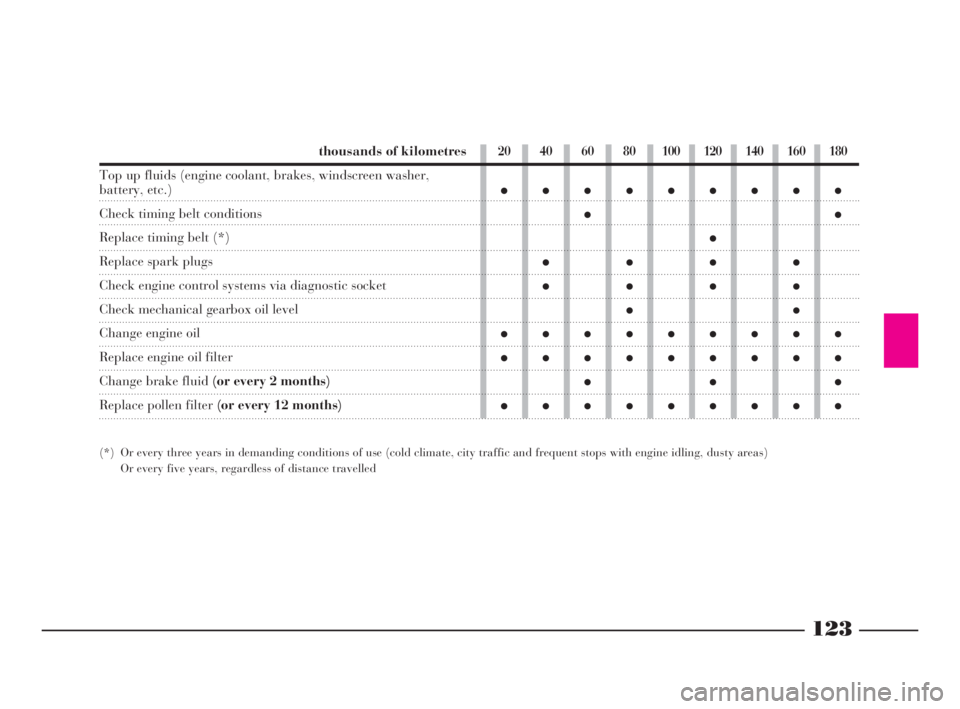
123
G
thousands of kilometres
Top up fluids (engine coolant, brakes, windscreen washer,
battery, etc.)
Check timing belt conditions
Replace timing belt (*)
Replace spark plugs
Check engine control systems via diagnostic socket
Check mechanical gearbox oil level
Change engine oil
Replace engine oil filter
Change brake fluid (or every 2 months)
Replace pollen filter (or every 12 months)
(*) Or every three years in demanding conditions of use (cold climate, city traffic and frequent stops with engine idling, dusty areas)
Or every five years, regardless of distance travelled
20 40 60 80 100 120 140 160 180
●●●●●●●●●
●●
●
●●●●
●●●●
●●
●●●●●●●●●
●●●●●●●●●
●●●
●●●●●●●●●
4C120-143 ING 11-03-2008 12:01 Pagina 123